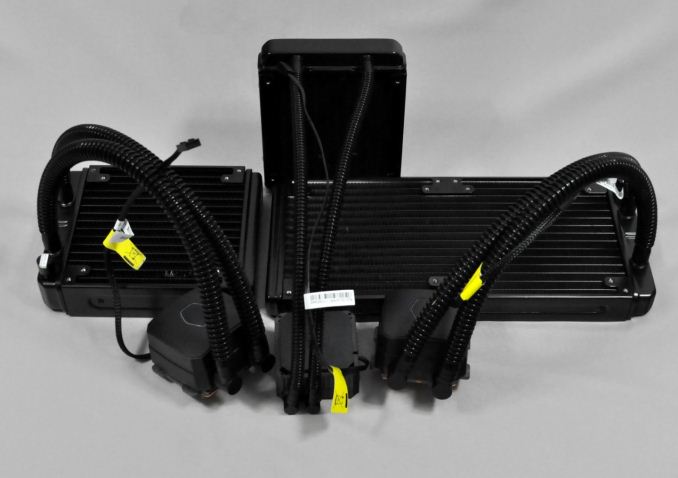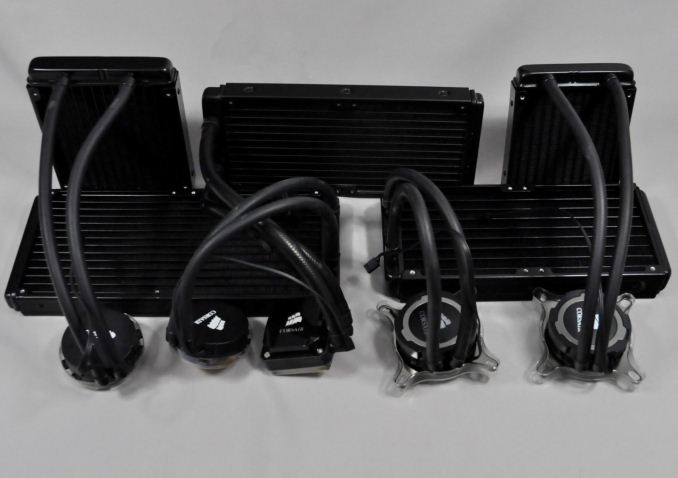Closed Loop AIO Liquid Coolers: 14-way Mega Roundup Review
by E. Fylladitakis on February 12, 2014 7:00 AM ESTCooler Master
It would seem that Cooler Master simply wanted to create the best performing AIO coolers available. In that respect, they certainly managed to do so, as their Nepton series coolers are constantly at the top of our high load thermal performance charts. On the other hand, one would have to be at least partially deaf in order to use these coolers with the fans anywhere near their maximum speed. Even with their voltage reduced down to 7V, both kits are rather noisy. It is not possible to run these kits quiet even if you reduce the voltage even further, as the fans are clearly audible from 1 meter away even at just 4.7V, the minimum voltage required to start them. Therefore, we simply cannot recommend them to anyone seeking a quiet cooling solution.
The Seidon 120V however is an entirely different product. Priced at just $49.99, it is more of an alternative to an average air cooler than competition for liquid cooling solutions. It fares relatively well at lower loads but its performance diminishes with thermal loads greater than 150W. With an average thermal resistance slightly above 0.014 °C/W, it will most likely be unable to compete with most extreme performance air coolers, and it has a particularly noisy pump, making it noisier than other 120mm AIO coolers. However, it has other merits, as it does not stress the motherboard with its weight and it requires very little space around the CPU area, making it ideal for special builds and/or systems that are moved around a lot.
Corsair
Corsair has such a vast selection of AIO cooling products that we could make a roundup just for them. Each of the five coolers that they shipped us for this roundup displays entirely different behavior; thus, each of them is suitable for a different type of user.
With the H75 Corsair is offering a compact 120mm AIO cooler but with two 120mm fans for extra performance. The H75 performs relatively well, although it generally does better at thermal loads lower than 150W due to the low capacity of its small radiator. The use of two fans however increases the noise of the system, giving the advantage to Enermax's Liqmax 120S if low-noise operation is the top priority.
The 140mm H90 on the other hand displays great all-around performance and very low noise levels. Even with its fan constantly running at maximum speed, the H90 can be considered fairly discreet and is comfortable for everyday use. If quiet computing is what drives you, the H90 deserves a very strong consideration.
Corsair informed us that the H100i is their most popular AIO cooler and we can see why. Despite its size, the H100i easily competes with coolers using significantly larger radiators. The stock fans have a wide operating range and the USB interface allows the user to adjust the performance/noise ratio to meet his or her exact needs. Furthermore, the size of the radiator makes the H100i compatible with a relatively wide array of cases.
After looking at the performance figures of the H100i, we felt disappointed by the performance of the newly released H105. The H105 hardly performs much better and it only does so when the thermal load is very high. Unfortunately, the thicker radiator can create compatibility issues and it also is more expensive than the H100i, all while lacking the USB interface that the H100i has. It is hard to recommend the H105 over the H100i for the slightly better thermal performance alone, unless of course maximum thermal performance is virtually the only concern of the user and a larger radiator cannot fit into the system.
Finally, the last AIO cooler from Corsair that we have tested, the Hydro H110, possibly stands as the performance winner of this roundup. Although it does not have the best thermal performance, it is very close to the top of the charts and manages to do so while maintaining very low noise levels. However, the size of the radiator limits the compatibility of the cooler with only a handful of cases currently available and, considering that the retail price of the H110 is over $125 at the time of this review, it is a costly thermal solution.












139 Comments
View All Comments
faster - Wednesday, February 12, 2014 - link
I want a closed loop system for my video card!My GTX780 is much louder than my CPU fan.
Liquid cooling was supposed to be how one obtained high performance quiet computing. Air cooling solutions should not be able to compete with a liquid cooling solution in the same environment, but it seems they do. How is that?
blanarahul - Wednesday, February 12, 2014 - link
"I want a closed loop system for my video card!"This. All the stupid OEMs want to disgruntle consumers. We already have more than enough great CPU coolers, but very few great GPU coolers. All I want is a card that is NOT pre-overclocked (but can be overclocked at my whims ;) ) and comes with a all-in-one liquid cooling solution. Is that too much to ask??
E.Fyll - Wednesday, February 12, 2014 - link
Oh, that is coming, soon. Stay tuned, should be online within a couple of weeks. :)Dribble - Wednesday, February 12, 2014 - link
True, for cpu's you don't need that big a cooler - all these lower power Intel cpu's don't pull 200W even overclocked. A big air cooler is sufficient. It'll work as well as a single 120mm fan radiator water cooler but is cheaper and more reliable.However graphics cards are another matter altogether - they pump out huge amounts of heat.
Hence either I WC my graphics card in which case I might as well get a system that can WC my cpu too, or I just stick to air cooling.
BuddhaBum44 - Wednesday, February 12, 2014 - link
You can always get the Kraken X40 and the bracket they make for 780s: https://www.nzxt.com/product/detail/138-kraken-g10...bj_murphy - Wednesday, February 12, 2014 - link
Solid review with some good information. I've been waiting for a "compendium" of sorts to link to people, explaining which closed loop coolers are the best. Thanks E. Fylladitakis, looking forward to more great articles!doggghouse - Wednesday, February 12, 2014 - link
What is a realistic load for a CPU? My 4770K has a max TDP of 84W... and I see a 3960X has a max of 130W. Are there actual CPUs that have anything above that, like 200W - 340W? If not, does it make sense to include those loads in the average thermal resistance, since these AIO coolers are going to be applied to a CPU, not to a synthetic load...?E.Fyll - Wednesday, February 12, 2014 - link
It depends on the CPU, of course. An overclocked CPU can easily surpass their max TDP rating. High thermal loads are useful for the extraction of proper thermal resistance ratings, plus they are easily reachable by modern GPUs (and GPUs are relevant, especially with AIO coolers; you'll see why soon enough). Of course, if you know the power requirements of your current CPU (if not overclocked, about 75% of its TDP), you can easily check the graph closest to it.dragosmp - Wednesday, February 12, 2014 - link
Hi,Great review, I like the methodology. It is nice to see all coolers tested with a constant load that is subject to much less randomness than a CPU power output.
I have two questions:
*is it possible to test all coolers at a certain noise level like 40dB +/-0.5dB; 7V testing is not that relevant for a cooler that is silent @10V, why would anyone silence it even further, save electricity?
*could you provide an order of magnitude of what clock speed and voltage a CPU would need to be at to achieve 340W/150W...etc. It would be useful to get our bearings vs the real world. A chart would be nice a bit like this:
.....................150W.................250W
Haswell DC....4.6GHz/1.25V......
Haswell QC....4.2GHz/1.27V......
FX83xx OC....4.1GHz/1.35V......
The reason for the last remark is that buying decisions are made also with cost in mind. One may think: I have max 30°C Tcase, 4.5GHz Haswell, what is the thermal conductivity I would need so the CPU never passes 70°C? Answer ==> review (maybe not the best cooler, maybe not the most expensive...). I have bought windows for my house like that.
E.Fyll - Wednesday, February 12, 2014 - link
40 dB(A) is not really "silent". I would rate <35 dB(A) as silent and still I can notice that in a very quiet room. 40 dB(A) is a slight humming noise, fairly quiet and most people just ignore it, yet it is easily noticeable. It is an interesting idea but that is not really possible when not all products can do at least 40 dB(A) and not practical, as the motherboard does not read the sound level, it just adjusts the voltage. 7 Volts are just high enough to ensure that (almost) every fan will start and about the same voltage as most motherboard will apply in their "quiet" mode. About the CPUs, I cannot do that as that would require me buying and testing every single CPU, which is not possible. Besides, every CPU is unique and the energy consumption also depends on several settings when overclocked, so it could easily bring misleading results. A single different setting can cause a massive change on consumption at the same exact frequency. For instance, a i7-3820 at 4.4 GHz consumes nearly 20% more energy with its voltage upped by 0.1V. It truly is a very interesting idea but a great deal of data and testing is required to create a proper database.